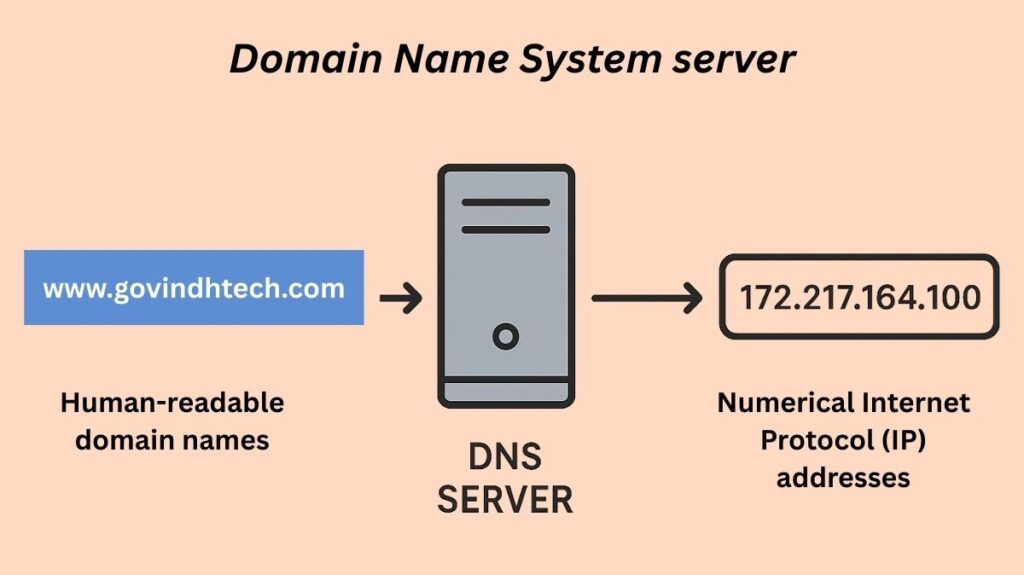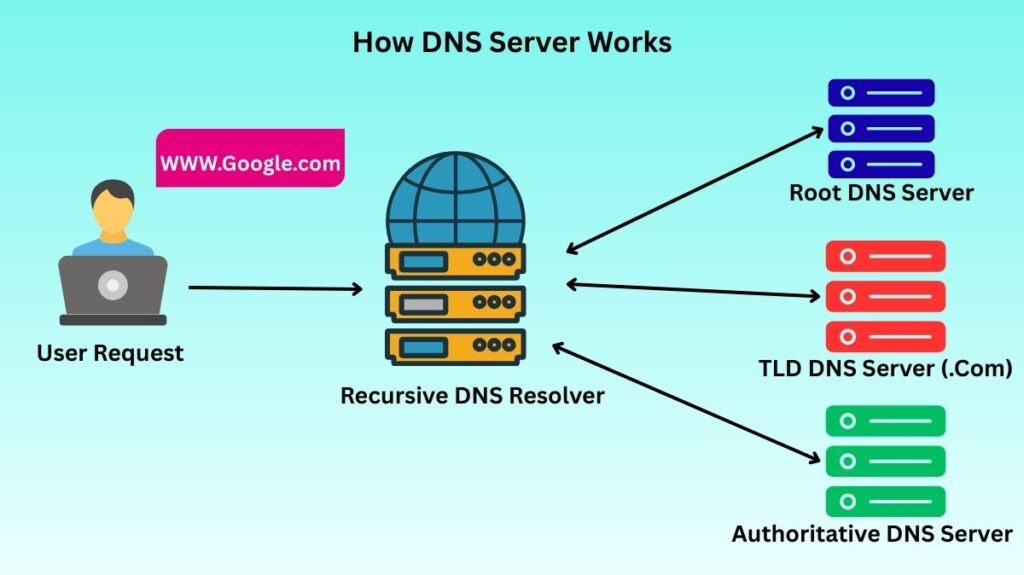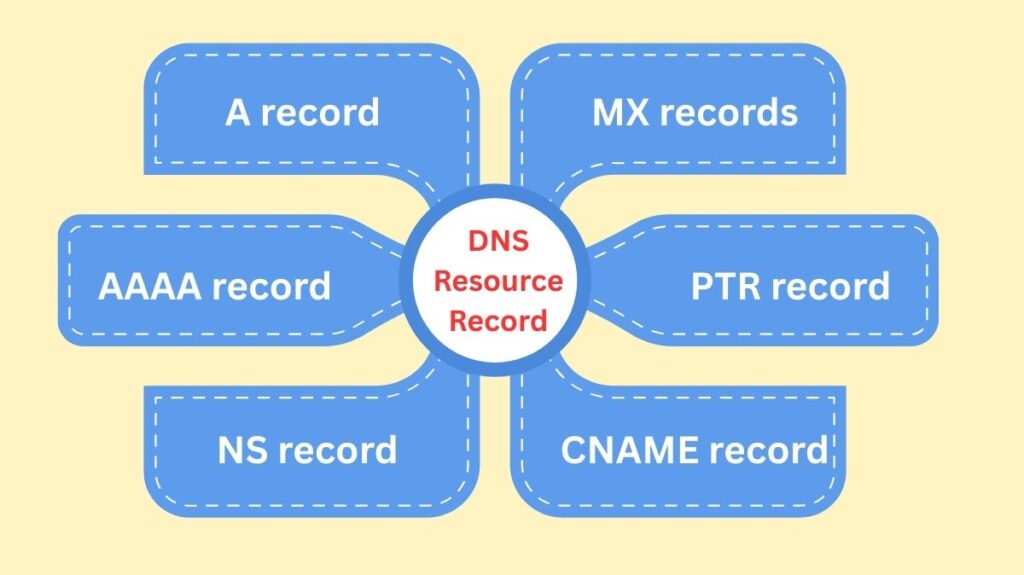This blog discusses a number of topics, including the Domain Name System server, its purpose and importance, how DNS servers works, DNS resource records, integration with DHCP, management and troubleshooting, types of DNS servers, key features and functions, and security aspects.
Domain Name System server

One essential piece of network infrastructure that serves as the “phonebook of the Internet” is a Domain Name System (DNS) server. Its major function is to convert computer-readable numerical Internet Protocol (IP) addresses, such as 172.217.164.100 or 52.157.161.254, into human-readable domain names, like “www.google.com” or “govindhtech.com.” DNS resolution or DNS lookup are terms used to describe this translation procedure.
Simply explained, a DNS server converts names into numbers so that computers may communicate with one another, acting as the internet’s equivalent of a phone book.
Purpose and Importance
DNS servers are essential since they greatly improve internet usability. In the absence of DNS, users would have to memorise lengthy, complicated IP addresses rather than simple domain names in order to access websites and other networked devices. Even in the face of enormous traffic volumes and changes in IP addresses or domain names, DNS servers provide a smooth user experience.
How DNS Server Works (The Resolution Process)?

Four different kinds of DNS servers cooperate to provide a client with the right IP address through a sequence of actions known as DNS resolution. Usually, this entire procedure takes milliseconds.
- User Request: Your computer first looks through its local cache when you enter a domain name into your browser. The request is routed to a recursive DNS server (often supplied by your Internet service provider, or ISP) if the IP address cannot be located locally.
- Query of the Recursive Resolver: The recursive resolver serves as an intermediary, taking the client’s query and subsequently contacting additional DNS servers on the client’s behalf.
- Query to Root Nameserver: A root nameserver receives the domain name query initially from the recursive resolver.
- Root Nameserver’s Response: Depending on the domain’s extension (e.g.,.com,.org,.net), the root nameserver responds by pointing the recursive resolver to the relevant Top-Level Domain (TLD) nameserver.
- TLD Nameserver Query: The TLD nameserver is then contacted by the recursive resolver.
- TLD Nameserver’s Reaction: In response, the TLD nameserver gives the IP address of the domain’s authoritative nameserver.
- Query to Authoritative Nameserver: The recursive resolver’s last step. The authoritative nameserver is queried.
- Response from the Authoritative Nameserver: The recursive resolver receives information from the authoritative nameserver, which contains the domain’s real DNS records, including its IP address.
- Final Delivery: The IP address is thereafter returned to your machine by the recursive resolver. This IP address is used by your browser to establish a direct connection with the website’s server and load the page.
Also Read About What are Network Bridges? Advantages of Bridge in Networking
Important Features and Functions
DNS servers carry out a number of additional crucial tasks in addition to resolution:
- Caching: DNS query responses are momentarily stored by DNS servers (as well as clients like browsers and operating systems). Because the resolver can bypass the entire lookup procedure, this greatly accelerates subsequent lookups for previously accessed domains. How long this cached data is valid is determined by a Time-To-Live (TTL) setting.
- Load Distribution: By resolving domain names to several servers, DNS can assist distribute network traffic and keep any one server from becoming overloaded.
- Email Routing: Emails are routed to the appropriate mail servers for a domain using DNS records, particularly MX (Mail Exchange) records.
- DNS Resource Records: A records (IPv4 addresses), AAAA records (IPv6 addresses), NS records (authoritative name servers), MX records (mail servers), PTR records (reverse DNS lookups), and CNAME records (aliases) are among the different kinds of records that DNS servers maintain.
Integration with DHCP
The Dynamic Host Configuration Protocol (DHCP) and DNS are closely related:
- As part of their network configuration, DHCP servers usually give clients the IP addresses of DNS servers.
- Stateless Address Autoconfiguration (SLAAC) in IPv6 networks enables a host to use Neighbour Discovery Protocol (NDP) packets to ascertain its own global unicast address. However, as SLAAC by itself does not offer a list of DNS server addresses or other setup options, it frequently works in conjunction with stateless DHCPv6. As an alternative, IPv6 also enables RA-based DNS Server (RDNSS) configuration, which eliminates the requirement for a separate stateless DHCP server by having routers include the DNS list directly in their NDP Router Advertisement (RA) messages.
- When hosts get an IP address lease, DNS entries can be immediately updated by integrating Dynamic DNS (DDNS) with DHCP.
Management and Troubleshooting
Network administrators control DNS configurations and resolve problems:
- Router Configuration: Using commands like ip domain-lookup (to enable DNS lookup), ip name-server (to specify DNS server IP addresses), and ip domain-name (to attach a domain name to hostname queries), Cisco IOS devices can be set up to use DNS for hostname resolution. This feature can be turned off using the no ip domain-lookup command.
- Local Host Tables: Using the ip host command, administrators can manually create a static host table on a device to resolve names locally for smaller networks or particular devices. For big networks, this approach isn’t scalable, though.
- Troubleshooting: Trying to ping a destination using both its hostname and IP address is a popular troubleshooting method. A DNS configuration error or resolution problem is indicated if pinging the IP address is successful but pinging the hostname is unsuccessful. DNS problems can be diagnosed with commands like nslookup (on Windows/Linux) and debug domain (on Cisco routers).
Types of DNS Servers
Four main server types are used by the dispersed DNS system:
Recursive DNS Server (or DNS Resolver/Recursor)
The initial point of contact for a user’s DNS query is the Recursive DNS Server, also known as the DNS Resolver/Recursor. It is in charge of determining the solution by either requesting information from the user’s cache or by contacting the other DNS servers. Though there are other solutions, such as Cloudflare’s 1.1.1.1, the majority of internet users use a recursive resolver that is supplied by their ISP.
Root Nameserver
At the very top of the DNS hierarchy are the Root Nameservers. The Internet Corporation for Assigned Names and Numbers (ICANN) is in charge of overseeing 13 logical root nameservers that are run by different organizations worldwide. Based on the domain extension, they point recursive resolvers to the appropriate TLD nameserver.
Top-Level Domain (TLD) Nameserver
A TLD nameserver keeps track of data for all domain names that have a lot in common, such as country codes like.uk or.us or extensions like.com,.org,.net,.edu, or.gov. overseen by ICANN’s Internet Assigned Numbers Authority (IANA). It guides the recursive resolver to the domain’s particular authoritative nameserver.
Authoritative Nameserver
The “final authority” for a certain domain is the authoritative nameserver. It gives the recursive resolver the conclusive response and contains the real DNS entries, such as the IP address (A record) or an alias (CNAME record). Anycast routing is used by Cloudflare DNS to disperse authoritative nameservers for dependability.
Other Types of DNS Servers
- Primary and Secondary DNS Servers: To guarantee uninterrupted service in the event of a primary DNS server failure, Internet service providers (ISPs) frequently set up both primary and secondary DNS servers.
- Default vs. Alternative DNS Servers: For better privacy or speed, users can opt to use alternative public DNS servers (such as Google DNS with IPs 8.8.8.8 and 8.8.4.4, Quad9, OpenDNS) rather than their ISP’s default servers.
- Public DNS servers: Usually set up by ISPs, they are available to anybody with an internet connection. They support traffic steering, aid in the management of authoritative name servers, and improve network efficiency.
- Private DNS servers: Usually a component of a Virtual Private Network (VPN), they are utilised inside an enterprise and are firewall-protected. Only allowed members can access them, and they only store and resolve internal IP addresses.
DNS Resource Record

In order to resolve names, DNS servers keep a variety of resource records, each of which includes the name, address, and record type:
- A record: Assigns an IPv4 address to a hostname.
- AAAA record: The AAAA record (commonly pronounced “quad-A”) maps a hostname to an IPv6 address.
- NS record: Indicates a domain’s authoritative name server.
- MX records: These are used to route emails and specify a mail exchange server for a domain.
- PTR record: Converts an IP address back to a fully qualified domain name (FQDN) during reverse DNS lookups.
- CNAME record: An existing hostname’s canonical name or alias is defined by the CNAME record.
The DNS process on the server first examines its own records when a client submits a query. It makes contact with other servers if it is unable to resolve the name using the records it has saved.
Also Read About Importance Of Computer Network Security Protect Your Data
Aspects of Security
The security of DNS servers is crucial since they are essential parts of the infrastructure. Network operations can be seriously disrupted by attackers who are able to take over or mimic a DNS server. Historically, DNS was susceptible to hijacking because it lacked built-in security measures to validate data in answers. To reduce these concerns, modern DNS implementations include security features like router packet filters and digital signatures. Because static hostname entries are configured locally and don’t require external enquiries, they are thought to be the most secure name resolving technique for routers and switches.
